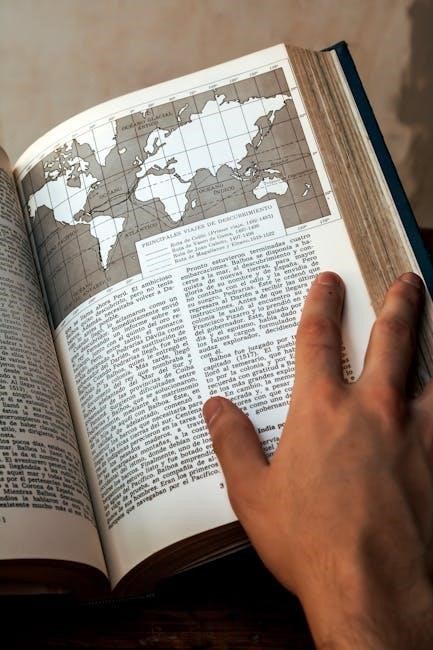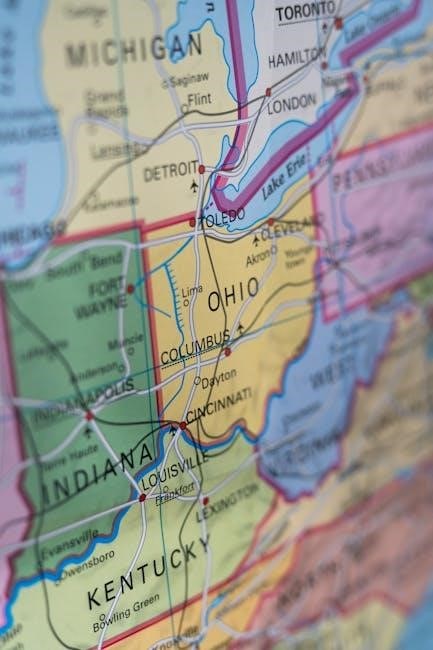
APUSH Unit 8 spans 1945 to 1980, focusing on post-WWII America, the Cold War, Civil Rights, economic growth, and social transformations. This period shaped modern American society, emphasizing continuity and change in political, cultural, and economic landscapes, crucial for understanding the nation’s evolution and its global role.
1.1 Overview of Period 8 (1945-1980)
Period 8 (1945-1980) covers post-WWII America, marked by significant political, social, and economic transformations. The Cold War dominated foreign policy, while the Civil Rights Movement reshaped domestic society. The U.S. experienced unprecedented economic growth, suburbanization, and technological advancements. This era saw the rise of consumer culture, mass media, and counterculture movements. Key events include the Korean and Vietnam Wars, the Cuban Missile Crisis, and landmark legislation like the Civil Rights Act. Understanding this period is crucial for grasping America’s global influence, internal struggles, and the evolution of its identity during the latter half of the 20th century.

1.2 Key Themes and Concepts
Key themes in APUSH Unit 8 include the Cold War rivalry, Civil Rights, economic prosperity, and social change. The struggle between communism and capitalism defined U.S. foreign policy, while the Civil Rights Movement sought racial equality. Economic growth and consumerism characterized the post-war boom, alongside technological advancements. Suburbanization and mass media influenced culture, while the counterculture movement challenged traditional norms. These themes highlight the tension between continuity and change, shaping America’s identity and global role during this transformative period, essential for understanding modern U.S. history and its lasting impacts.
1.3 Importance of Understanding Post-WWII America
Understanding post-WWII America is crucial for grasping the origins of today’s global political and social structures. This period saw the U.S. emerge as a superpower, shaping Cold War geopolitics and international relations. Domestically, it laid the groundwork for Civil Rights advancements and economic prosperity. Studying this era reveals how America addressed challenges like communism, racial inequality, and social change, influencing its role in the modern world. This knowledge provides insights into the complexities of American identity, policies, and cultural shifts, essential for analyzing historical continuity and change, and their relevance to contemporary issues.

The Cold War
The Cold War was a decades-long ideological and geopolitical rivalry between the U.S. and USSR, marked by political tensions, Proxy wars, and the arms race, shaping global dynamics.
2.1 Causes of the Cold War
The Cold War emerged from ideological differences between the U.S. and USSR, with capitalism and communism clashing. Post-WWII power vacuums, Soviet expansion into Eastern Europe, and the Iron Curtain’s formation heightened tensions. The Truman Doctrine and Marshall Plan reflected U.S. containment policies, while the USSR viewed these as threats; Historical suspicions, the Red Scare, and McCarthyism in the U.S. intensified fears of communism. The arms race and nuclear deterrence further escalated the rivalry, creating a decades-long geopolitical standoff that shaped global politics and alliances.
2.2 Key Cold War Events (1947-1960)

Key Cold War events from 1947 to 1960 include the Truman Doctrine and Marshall Plan, which aimed to contain communism in Europe. The Berlin Blockade and Airlift (1948-1949) highlighted tensions over Germany. The Korean War (1950-1953) was a direct military conflict of the Cold War. The formation of NATO (1949) and the Warsaw Pact (1955) established opposing alliances. The Hungarian Revolution (1956) and its suppression by the USSR showcased Soviet control in Eastern Europe. McCarthyism in the U.S. reflected domestic fears of communism. The U-2 Spy Incident (1960) and the development of the hydrogen bomb escalated the arms race, while the Civil Rights Movement began to intersect with Cold War diplomacy.
2.3 Cold War Policies and Ideologies
Cold War policies were shaped by the ideologies of containment and deterrence. The U.S. adopted containment, aiming to prevent communist expansion, as outlined in George Kennan’s “Long Telegram” and the Truman Doctrine. The Domino Theory justified interventions in Korea and Vietnam. The Soviet Union promoted communist expansion and socialism in one country. Mutual Assured Destruction (MAD) became a central deterrence strategy. The U.S. also pursued rollback, a more aggressive approach, while the Soviets emphasized peaceful coexistence. These ideologies fueled the arms race, proxy wars, and the formation of alliances like NATO and the Warsaw Pact, shaping global tensions for decades.

Civil Rights Movement
The Civil Rights Movement sought to end racial inequality and segregation through nonviolent protests, legal challenges, and grassroots activism. Key events like the Montgomery Bus Boycott and the March on Washington highlighted the struggle for equality, culminating in landmark legislation such as the Civil Rights Act and Voting Rights Act, driven by figures like Martin Luther King Jr. and organizations like the NAACP.
3.1 Major Events of the Civil Rights Movement
The Civil Rights Movement was marked by pivotal events that challenged racial segregation and inequality. The Montgomery Bus Boycott (1955-1956), sparked by Rosa Parks’ defiance, ended with the U.S. Supreme Court ruling segregation on public buses unconstitutional. The March on Washington (1963) showcased Martin Luther King Jr.’s iconic “I Have a Dream” speech, advocating for racial justice. The Selma to Montgomery Marches (1965) highlighted voting rights issues, leading to the Voting Rights Act. Additionally, the integration of Little Rock Central High (1957) demonstrated federal commitment to desegregation, while sit-ins and freedom rides further pushed for equality and social change.
3.2 Key Legislation and Court Cases
The Civil Rights Movement was strengthened by landmark legislation and court decisions. Brown v. Board of Education (1954) overturned Plessy v. Ferguson, declaring segregation in public schools unconstitutional. The Civil Rights Act of 1964 prohibited racial and sexual discrimination in employment, education, and public accommodations. The Voting Rights Act of 1965 protected African Americans’ voting rights, eliminating literacy tests and poll taxes. The Fair Housing Act of 1968 banned racial discrimination in housing. These legal milestones were pivotal in dismantling institutional racism and advancing equality in America.
3.3 Influential Figures and Organizations
Key figures like Martin Luther King Jr. and Rosa Parks played pivotal roles in the Civil Rights Movement. King advocated for nonviolent resistance, while Parks sparked the Montgomery Bus Boycott. Malcolm X emerged as a voice for radical change, challenging racism through the Nation of Islam. Influential organizations included the NAACP, which legally challenged segregation, the Southern Christian Leadership Conference (SCLC), and the Student Nonviolent Coordinating Committee (SNCC). These individuals and groups collectively pushed for racial equality and social justice, reshaping America’s legal and social landscape.

Economic Developments Post-WWII
Post-WWII, the U.S. experienced a remarkable economic boom, driven by government policies, technological advancements, and consumer spending. This era marked unprecedented prosperity, establishing America as a global economic powerhouse.
4.1 Post-War Economic Boom
The post-WWII era saw unprecedented economic growth in the U.S., driven by government policies, consumer spending, and technological innovation. The federal government invested heavily in infrastructure and research, while the GI Bill enabled veterans to pursue education and homeownership. Industries like automobiles, electronics, and aerospace thrived, creating millions of jobs. Suburbanization and the rise of credit further fueled consumer culture, making the U.S. the world’s leading economy. This boom solidified America’s global influence and set the stage for decades of prosperity, transforming the nation into a superpower.
4.2 Consumer Culture and Its Impact
The post-war era witnessed the rise of consumer culture, fueled by economic prosperity and mass production. Americans embraced credit cards, suburban living, and mass media, creating a culture of consumption. Advertising played a pivotal role in shaping desires, while industries like automobiles and electronics boomed. This shift transformed societal values, prioritizing material comfort and individualism. Consumer culture also influenced politics, as governments leveraged economic growth to showcase capitalism’s superiority over communism. The rise of suburbia and mass media further solidified these trends, shaping a new American identity centered on consumption and progress.
4.3 Technological Advancements
Post-WWII America experienced transformative technological advancements that reshaped society and the economy. The space race, spurred by Cold War rivalry, led to historic achievements like the Moon landing. Computers became integral to industries, with the development of integrated circuits and microprocessors; The internet’s precursor, ARPANET, emerged in the 1960s. Medical breakthroughs, such as vaccines and MRI technology, improved healthcare. Environmental technologies, like catalytic converters and recycling programs, addressed growing ecological concerns. These innovations not only boosted productivity but also redefined daily life, solidifying America’s position as a global leader in technology and innovation.

Social and Cultural Changes
Post-WWII America underwent significant social and cultural transformations. Suburbanization reshaped living patterns, while mass media and consumer culture influenced daily life. The 1960s-70s counterculture movement challenged traditional values, promoting civil rights and feminist reforms, redefining American identity and society.
5.1 The Rise of Suburbanization
The post-WWII era saw a massive migration of Americans to suburban areas, driven by government policies, economic prosperity, and the desire for homeownership. The GI Bill and Federal Housing Administration (FHA) loans enabled veterans and middle-class families to purchase homes. Suburbanization transformed family life, fostering a sense of community and domesticity. However, it also contributed to urban decay and racial segregation, as wealthier, predominantly white populations moved out of cities. This shift reflected broader societal aspirations for stability and consumer culture, while also highlighting growing socioeconomic divides and the need for civil rights reforms.
5.2 Mass Media and Popular Culture
The post-WWII era witnessed the rise of mass media, with television, radio, and cinema becoming central to American life. Shows like I Love Lucy and Leave It to Beaver reflected suburban ideals, while rock ‘n’ roll artists like Elvis Presley reshaped music and youth culture. Magazines such as Life and Look captured the nation’s attention, and Hollywood films often explored societal tensions. This period saw the blending of entertainment and consumer culture, with media shaping public opinion and fostering a shared national identity, while also sometimes challenging traditional norms and values.
5.3 The Emergence of the Counterculture Movement
The counterculture movement emerged in the 1960s, primarily among young people, as a rebellion against mainstream values and social norms. It was fueled by opposition to the Vietnam War, racial inequality, and traditional gender roles. Key events included widespread protests, civil rights activism, and the rise of hippie culture. The movement emphasized peace, love, and individual freedom, influencing music, fashion, and alternative lifestyles. It also challenged political and social institutions, fostering a cultural shift that continues to impact American society, while often clashing with the era’s more conservative elements. This movement became a defining feature of the 1960s and 1970s.

Foreign Policy and Global Conflicts
U.S. foreign policy during the Cold War focused on containment, with proxy wars in Korea and Vietnam, and crises like the Cuban Missile Crisis shaping global tensions.
6.1 U.S. Foreign Policy During the Cold War
U.S. foreign policy during the Cold War centered on containment of communism, as outlined in the Truman Doctrine and Marshall Plan. The creation of NATO and involvement in the Korean and Vietnam Wars reflected this strategy. The Cuban Missile Crisis brought the world to the brink of nuclear war, while policies like détente later sought to ease tensions. These actions underscored America’s role as a global superpower, balancing idealism with realism to counter Soviet influence and protect democratic interests worldwide.
6.2 The Korean and Vietnam Wars
The Korean War (1950–1953) began as a civil conflict between North and South Korea, escalating into a global crisis with U.S. intervention under the UN flag. The war ended in a stalemate with the Armistice Agreement, establishing the DMZ. The Vietnam War (1955–1975) involved the U.S. supporting South Vietnam against communist North Vietnam. Key events included the Gulf of Tonkin incident, the Tet Offensive, and widespread anti-war protests. Both wars reflected Cold War ideologies, with the U.S. aiming to contain communism, while also highlighting the challenges of military involvement in foreign conflicts and their societal impacts.
6.3 The Cuban Missile Crisis
The Cuban Missile Crisis (1962) was a pivotal Cold War event where the U.S. and Soviet Union nearly engaged in nuclear war. After discovering Soviet missile sites in Cuba, President Kennedy imposed a naval quarantine to prevent further missile deliveries. Tensions escalated, but a diplomatic resolution was reached when the Soviets agreed to dismantle the sites in exchange for a U.S. promise not to invade Cuba and the removal of U.S. missiles from Turkey. This crisis highlighted the dangers of nuclear brinkmanship and led to increased efforts in diplomacy, including the establishment of a direct communication hotline between the two superpowers.

The Great Society and Its Programs
Led by Lyndon B. Johnson, the Great Society aimed to address poverty, education, healthcare, and civil rights through landmark legislation like Medicare, Medicaid, and HUD, transforming American society.
7.1 Lyndon B. Johnson and the Great Society
Led by President Lyndon B; Johnson, the Great Society was a series of domestic programs aimed at eliminating poverty and racial injustice. Building on the New Deal, Johnson’s vision sought to create a more equitable society. Key initiatives included the Civil Rights Act of 1964, the Voting Rights Act of 1965, and the creation of Medicare and Medicaid. These policies significantly expanded federal involvement in social welfare, reflecting Johnson’s commitment to “unconditional war on poverty” and fostering meaningful change in American society during the 1960s.
7.2 Major Policies and Reforms
The Great Society introduced transformative policies aimed at addressing social inequalities and improving quality of life. Key reforms included the Civil Rights Act of 1964 and the Voting Rights Act of 1965, which dismantled racial segregation and secured voting rights for African Americans. Medicare and Medicaid expanded healthcare access for the elderly and low-income individuals. Educational reforms like Head Start and federal aid to schools targeted poverty and inequality. These policies reflected Johnson’s vision of a “War on Poverty” and sought to create a more just and equitable society, leaving a lasting legacy in American social policy.
7.3 Impact of the Great Society Programs
The Great Society programs had a profound impact on American society, reducing poverty and addressing systemic inequalities. Medicare and Medicaid expanded healthcare access, while educational reforms improved opportunities for marginalized groups. Civil Rights legislation dismantled legal segregation, fostering social progress despite ongoing resistance. However, critics argued that some programs created dependency, and the Vietnam War diverted funds, limiting their full potential. Despite challenges, these reforms left a lasting legacy, shaping modern social policy and advancing the fight for equality and justice in the United States.

Understanding Period 8 Themes
Period 8 explores themes of continuity and change, highlighting shifts in American society, politics, and culture from 1945 to 1980. Key themes include the Cold War, Civil Rights, economic growth, and social transformations, emphasizing how these developments shaped the nation’s identity and global role. Understanding these themes is crucial for analyzing the evolution of American values and policies during this transformative era.
8.1 Continuity and Change
Understanding continuity and change in Period 8 involves analyzing how post-WWII America maintained traditional values while undergoing significant transformations. The U.S. retained its capitalist democracy but shifted its global role, embracing international leadership during the Cold War. Domestically, civil rights movements challenged long-standing racial inequalities, leading to landmark legislation. Economic prosperity and consumer culture flourished, yet social unrest and countercultural movements emerged, reflecting a society in flux. These dynamics highlight how American society balanced enduring ideals with evolving priorities, shaping its identity and global influence during this transformative era.
8.2 Key APUSH Themes in Period 8
Period 8 emphasizes themes such as American Identity, Politics, Economy, and Culture. The Cold War shaped U.S. identity through ideological battles, while the Civil Rights Movement redefined citizenship and equality. Economic transformations included post-war prosperity and consumerism, contrasting with later stagnation. Cultural shifts, like suburbanization and counterculture movements, reflected changing societal values. These themes highlight how Americans navigated global influence, domestic unrest, and evolving definitions of freedom, laying the groundwork for modern debates on identity, economy, and international relations.
8.3 Historical Thinking Skills for the Exam
Mastering historical thinking skills is crucial for success in APUSH. Period 8 requires contextualization, understanding events within their time frame. Comparison and causation skills help analyze relationships between events, like the Cold War and Civil Rights. Continuity and change over time are central, as seen in shifting societal values. Additionally, using evidence-based reasoning and interpreting historical sources effectively are essential. Practicing these skills ensures a deeper understanding of Period 8 themes and improves performance on essays and multiple-choice questions.